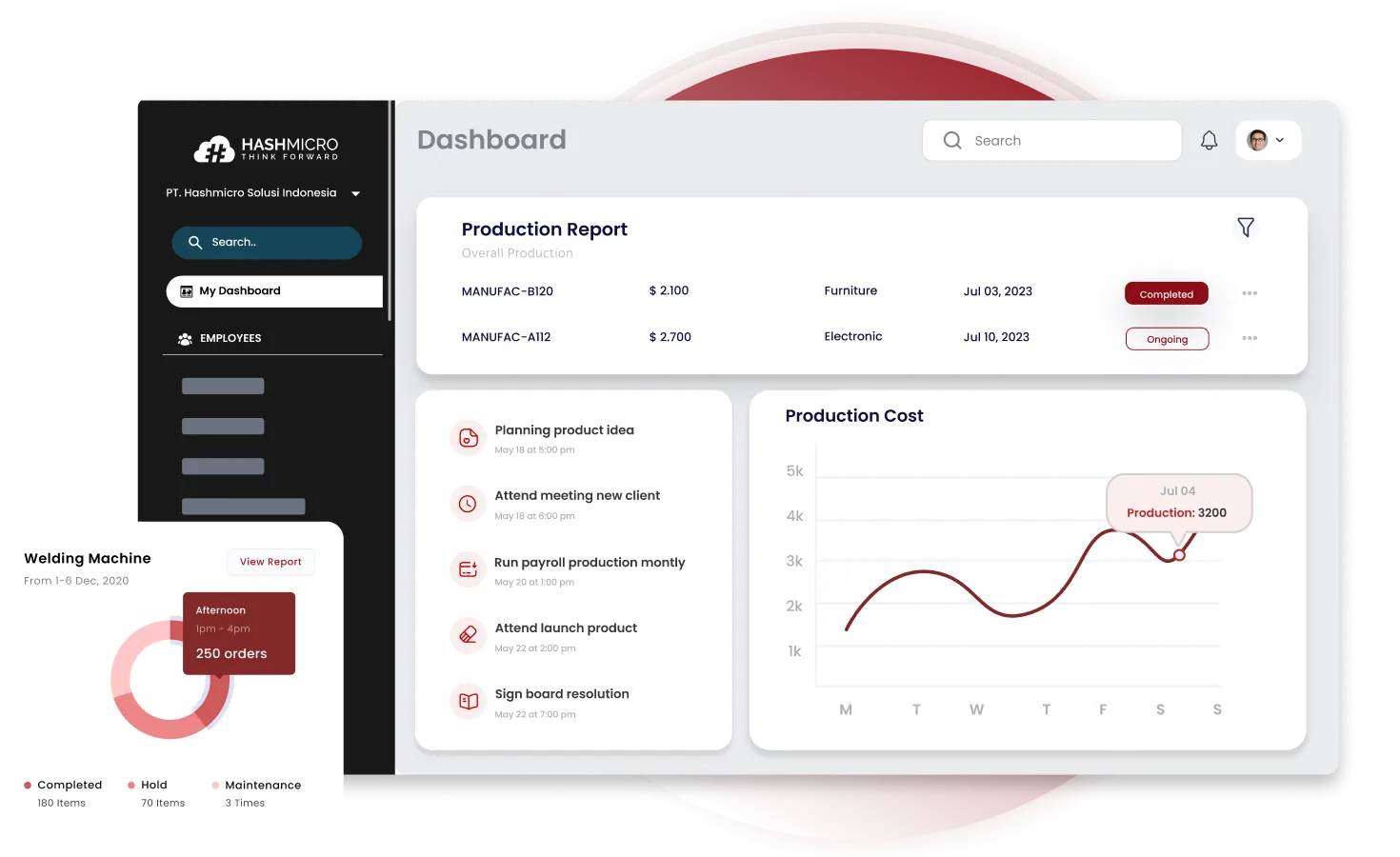OEE is a KPI or assessment standard mandatory for all manufacturers in the Philippines. But why is it so crucial? It provides critical insights into your company’s growth. By leveraging OEE, businesses can pinpoint specific areas within their work systems that require improvement.
Understanding overall equipment effectiveness helps manufacturers assess their performance effectively. For example, if your overall equipment effectiveness score drops below 60%, your business may be underperforming and need immediate attention.
Therefore, learn more about OEE, its meaning, the overall equipment effectiveness formula, its benefits, and the challenges you can face. Read on to find the quickest and most efficient overall equipment effectiveness solutions for manufacturing businesses in the Philippines.
Key Takeaways
|
Table of Contents

What is OEE?
Overall Equipment Effectiveness, or OEE is a key maintenance metric that evaluates an asset’s productivity. It integrates three core factors: asset availability, performance, and production quality, offering a comprehensive view of an asset’s efficiency throughout the manufacturing process.
Availability refers to how reliably an asset operates whenever it is required. Performance focuses on the asset’s production capacity, indicating how much it can produce efficiently. Meanwhile, quality assesses the number of high-quality outputs the asset generates, reflecting its overall effectiveness.
What is the OEE Formula?
The OEE formula is:
Business People, if you are worrying about how to implement this formula into an actual count, chill lang! Here is an example of using the OEE formula for manufacturing businesses:
A manufacturing company produces bicycles in the Philippines. It wants to know the OEE of their production process using the following data:
- Good count: 380 units
- Ideal cycle time: 1 minute per unit
- Planned production time: 8 hours (480 minutes)
The calculation is as follows:
This means the production process operates at an efficiency of 79.17%, providing valuable insights into their current operational performance.
Key Components of the OEE Framework for Filipino Businesses

- Good count: The number of units that meet quality standards, excluding any defective or reworked items. Mahalaga ito upang masuri ang kalidad ng produksiyon.
- Ideal cycle time: The minimum time needed to produce one unit if everything runs perfectly.
- Planned production time: The total time scheduled for production minus any planned downtime like maintenance.
- Fully productive time: The actual time the equipment is running at its best, producing quality units without any interruptions.
What does OEE Mean for Maintenance?
Overall equipment effectiveness is a game-changer for maintenance teams. It pinpoints issues, reduces downtime, and ensures machines run at peak performance. Here’s how OEE impacts maintenance:
| Aspect | Explanation | Benefits for Maintenance |
| Availability | Measures downtime and operating time. | Pinpoints when and why downtime occurs, aiding in preventive measures. |
| Performance | Compares actual speed to ideal speed. | Helps identify issues affecting machine speed, guiding maintenance actions. |
| Quality | Assesses defect rates in production. | Reveals quality-related problems that maintenance can address. |
| Data-Driven Decisions | Uses OEE data to plan maintenance. | Improves scheduling and reduces unplanned repairs. |
Are you prepared to enhance your maintenance strategy? No more wondering how automated calculations could change the game. With OEE in manufacturing software, you can quickly assess your equipment’s overall effectiveness.
No more manual calculations or guesswork. Get instant, accurate OEE reports to make smarter maintenance decisions. Check out the flexible pricing schemes below to unlock the full potential of your equipment today.

Benefits of Conducting OEE
Conducting overall equipment effectiveness inside the manufacturing software brings several key advantages, such as:
- Uncovers inefficiencies: OEE highlights hidden losses like downtime, slow production, and defects, allowing targeted improvements.
- Boosts productivity: OEE helps increase output without needing extra resources by optimising equipment use.
- Enhances quality: Tracks defects to reduce waste, ensuring more high-quality products.
- Better maintenance: Offers insights for proactive maintenance, preventing major breakdowns and extending equipment life.
- Informed decisions: Provides real-time data, helping managers make smarter, faster decisions for continuous improvement.
Challenges for Improving Overall Equipment Effectiveness
Enhancing OEE can be challenging due to several factors:
- Unplanned downtime: Sudden equipment failures can disrupt production, making it hard to maintain optimal OEE. Identifying and addressing the root causes of these breakdowns can be complex.
- Inconsistent production speeds: Variability, often due to operator errors or equipment wear, can prevent machinery from operating at the ideal cycle time.
- Quality issues: Maintaining a high-quality output is difficult, especially when defects arise from raw materials or outdated processes. Reducing defects requires continuous monitoring and adjustments.
- Data collection: Accurately tracking OEE metrics in real-time can be complex without the right tools, often leading to incomplete or inaccurate data that affects decision-making.
- Change resistance: Employees may resist new processes or technologies to improve OEE, making implementing changes effectively difficult.
How to Improve OEE
You’ve done OEE calculations, but the process still feels ineffective, lengthy, and error-prone? Hay naku! This is a sign that you must improve your overall equipment effectiveness immediately! But how?
- Minimize downtime: Regularly maintain equipment and quickly address issues to reduce unplanned stops.
- Optimize production speeds: Monitor and adjust machine speeds to match the ideal cycle time without compromising quality.
- Improve quality control: Implement strict quality checks to catch defects early and reduce rework or waste.
- Standardize processes: Use standardized operating procedures to ensure consistent performance and prevent variability in production.
- Use OEE tracking tools: Invest in real-time software that tracks OEE to quickly identify and address issues.
Boost Your Overall Equipment Effectiveness with HashMicro Software

HashMicro is a robust manufacturing software vendor in the Philippines that has been operating since 2015. With incredible milestones, HashMicro offers high-quality software with countless benefits, including a free demo, free user additions without additional cost, and flexible customization.
With over 1750 companies relying on HashMicro’s manufacturing software, the OEE calculation could happen by the use of these features:
- Manufacturing requisition planning: Help plan detailed production needs and ensure the availability of raw materials and other resources for the production process.
- Quality control: A system that ensures that stored, processed and delivered products meet established quality standards.
- Manufacturing production scheduling: A feature that allows companies to plan production schedules based on demand forecasts that are based on demand history.
- Finished goods production simulation: A feature to simulate the number of products produced based on the warehouse’s ingredients in the Bill of Materials (BoM).
- Gantt Chart management: This position assists in production planning, scheduling machine and labour capacity, and identifying schedule conflicts.
Conclusion
Improving Overall Equipment Effectiveness, or OEE in manufacturing businesses to boost efficiency and growth is essential. While it offers benefits like increased productivity and better quality, challenges like unplanned downtime and production inconsistencies can arise.
HashMicro’s manufacturing software can help overcome these challenges with real-time tracking, automated maintenance, and quality control. Want to see how it can improve your operations? Schedule a free demo today to explore its full potential.

FAQ About OEE
-
What is a good OEE rate?
An OEE score above 85% is regarded as world-class. Most manufacturing operations fall within the 65% to 85% range. If a plant has an OEE score below 65%, it likely faces significant inefficiencies. Such a low score serves as a warning sign.
-
What is the difference between MTBF and OEE?
MTBF (Mean Time Between Failures) measures how long equipment runs before breaking down, focusing on reliability. OEE (Overall Equipment Effectiveness) looks at overall efficiency, combining availability, performance, and quality into one percentage. MTBF checks uptime, while OEE gives a broader view of productivity.
-
Is high MTBF good?
A high MTBF indicates that breakdowns are less likely, but it doesn’t guarantee they will never happen. Every system and component has a limited lifespan, and failures can result from factors like wear and tear, environmental conditions, and manufacturing defects.
{
“@context”: “https://schema.org”,
“@type”: “FAQPage”,
“mainEntity”: [{
“@type”: “Question”,
“name”: “What is a good OEE rate?”,
“acceptedAnswer”: {
“@type”: “Answer”,
“text”: “An OEE score above 85% is regarded as world-class. Most manufacturing operations fall within the 65% to 85% range. If a plant has an OEE score below 65%, it likely faces significant inefficiencies. Such a low score serves as a warning sign.”
}
},{
“@type”: “Question”,
“name”: “What is the difference between MTBF and OEE?”,
“acceptedAnswer”: {
“@type”: “Answer”,
“text”: “MTBF (Mean Time Between Failures) measures how long equipment runs before breaking down, focusing on reliability. OEE (Overall Equipment Effectiveness) looks at overall efficiency, combining availability, performance, and quality into one percentage. MTBF checks uptime, while OEE gives a broader view of productivity.”
}
},{
“@type”: “Question”,
“name”: “Is high MTBF good?”,
“acceptedAnswer”: {
“@type”: “Answer”,
“text”: “A high MTBF indicates that breakdowns are less likely, but it doesn’t guarantee they will never happen. Every system and component has a limited lifespan, and failures can result from factors like wear and tear, environmental conditions, and manufacturing defects.”
}
}]
}












































